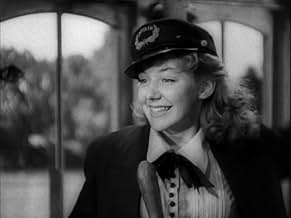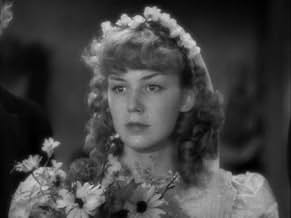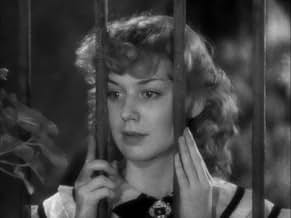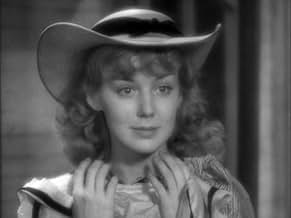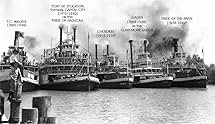IMDb रेटिंग
6.9/10
1.4 हज़ार
आपकी रेटिंग
अपनी भाषा में प्लॉट जोड़ेंA Louisiana con man enters his steamboat into a winner-take-all race with a rival while trying to find a witness to free his nephew, about to be hanged for murder.A Louisiana con man enters his steamboat into a winner-take-all race with a rival while trying to find a witness to free his nephew, about to be hanged for murder.A Louisiana con man enters his steamboat into a winner-take-all race with a rival while trying to find a witness to free his nephew, about to be hanged for murder.
- निर्देशक
- लेखक
- स्टार
- पुरस्कार
- कुल 3 जीत
C.E. Anderson
- Jailer
- (बिना क्रेडिट के)
Sam Baker
- Undetermined Role
- (बिना क्रेडिट के)
William 'Billy' Benedict
- Breck
- (बिना क्रेडिट के)
Heinie Conklin
- Jailbird
- (बिना क्रेडिट के)
Tex Cooper
- Townsman
- (बिना क्रेडिट के)
D'Arcy Corrigan
- Hangman
- (बिना क्रेडिट के)
Luke Cosgrave
- Labor Boss
- (बिना क्रेडिट के)
फ़ीचर्ड समीक्षाएं
Snake oil salesman Doctor John Pearly (Will Rogers) makes a bet with Captain Eli to race steamboats. He has to fix up an old steamboat. He hopes to have his nephew Duke as the pilot. Duke brings along swamp gal Fleety Belle who was abused by her family. He had killed a man. It's self-defense but the only witness is preacher The New Moses who has since gone away. Following John's advice, Duke turns himself in. He is set to hang unless the preacher is found.
There is a basic structural issue with the premise and the movie. The movie wants to be a fun, light-weight, silly steamboat race. On the other hand, nephew Duke is threatened with hanging and there is supposed to be danger. These two things often do not mix well together. For example, they need to find The New Moses who is often found on the river. One would expect John to be piloting his steamboat up and down the river spreading the word and looking for the preacher. Instead, he ends up spending his time racing and by happenstance run into the preacher. The race is plenty fun and then we're reminded that Duke is about to be hanged. It's a wacky hanging party.
There is a basic structural issue with the premise and the movie. The movie wants to be a fun, light-weight, silly steamboat race. On the other hand, nephew Duke is threatened with hanging and there is supposed to be danger. These two things often do not mix well together. For example, they need to find The New Moses who is often found on the river. One would expect John to be piloting his steamboat up and down the river spreading the word and looking for the preacher. Instead, he ends up spending his time racing and by happenstance run into the preacher. The race is plenty fun and then we're reminded that Duke is about to be hanged. It's a wacky hanging party.
Steamboat Round the Bend is one of 3 collaborations between director John Ford and actor Will Rogers, and was shot in 6 weeks in the Sacramento River Delta.
The commentary by Scott Eyman, on the 2006 DVD, is worth having apart from the film. Eyman is author of two books on director John Ford: Print the Legend, and John Ford: The Complete Films. His commentary is among the very best I have ever heard.
Standout scenes: An exquisite wedding ceremony brings tears even to Will Rogers's eyes, and he is not acting. Anne Shirley as Fleety Belle is stunning in her delicate beauty throughout. The "New Moses," Berton Churchill, is memorable in his role as a full-of-himself blowhard, as he was playing the prosecuting attorney in the 1934 "Judge Priest," another Ford-Rogers collaboration. Another reprise from Judge Priest is John Ford's brother Francis, again playing a drunk with amazing aim when he spits. A final highlight is supercharging the Claremore Queen firebox with the Pocahontas Remedy.
Some viewers are disturbed by Lincoln Perry's (Stepin Fetchit) character, but more disturbing to me was the lassoing of Moses! Scott Eyman gives a superb analysis of the dull and slow character played by Stepin Fetchittranscending the kneejerk politically-correct reaction of today, and placing Fetchit's characterization (and that of Hattie McDaniel in other films) in a larger context. He says "might I offer a modest proposal: Is it not now time to look past the stereotypes these actors portrayed-- and look at the art, and the warmth, with which they played them." Two other films with Rogers have the same charm and image of 19th Century American values; one is the Ford Rogers collaboration Judge Priest, and the other, also released in 1935, is In Old Kentucky.
Commentator Eyman says "taken together, the 3 Ford-Rogers films (Judge Priest, Dr. Boles, and Steamboat) rank with Ford's finest achievements." After Rogers's tragic death, 50,000 people filed by his closed casket, and 12,000 movie theaters went dark for two minutes.
The commentary by Scott Eyman, on the 2006 DVD, is worth having apart from the film. Eyman is author of two books on director John Ford: Print the Legend, and John Ford: The Complete Films. His commentary is among the very best I have ever heard.
Standout scenes: An exquisite wedding ceremony brings tears even to Will Rogers's eyes, and he is not acting. Anne Shirley as Fleety Belle is stunning in her delicate beauty throughout. The "New Moses," Berton Churchill, is memorable in his role as a full-of-himself blowhard, as he was playing the prosecuting attorney in the 1934 "Judge Priest," another Ford-Rogers collaboration. Another reprise from Judge Priest is John Ford's brother Francis, again playing a drunk with amazing aim when he spits. A final highlight is supercharging the Claremore Queen firebox with the Pocahontas Remedy.
Some viewers are disturbed by Lincoln Perry's (Stepin Fetchit) character, but more disturbing to me was the lassoing of Moses! Scott Eyman gives a superb analysis of the dull and slow character played by Stepin Fetchittranscending the kneejerk politically-correct reaction of today, and placing Fetchit's characterization (and that of Hattie McDaniel in other films) in a larger context. He says "might I offer a modest proposal: Is it not now time to look past the stereotypes these actors portrayed-- and look at the art, and the warmth, with which they played them." Two other films with Rogers have the same charm and image of 19th Century American values; one is the Ford Rogers collaboration Judge Priest, and the other, also released in 1935, is In Old Kentucky.
Commentator Eyman says "taken together, the 3 Ford-Rogers films (Judge Priest, Dr. Boles, and Steamboat) rank with Ford's finest achievements." After Rogers's tragic death, 50,000 people filed by his closed casket, and 12,000 movie theaters went dark for two minutes.
10zootjim
I first saw this movie with my grandfather fifty years ago. Our small-town theater was having classic movie month and Will Rogers was my grandfather's favorite. For a ten-year old boy this movie made a lasting impression of the freedom and romance once available to us in America but now lost forever. Aside from the instantly believable story line about an uncle and his orphaned nephew going together to buy an aging Mississippi River steamboat the pathos applies superbly to this day. The young man meets a girl, gets in a fight over her and is in trouble with the law. The kind uncle moves heaven and earth to help his deceased sister's son. The characters are all period and realistic according to my grandfather who knew people just like that. America was a religious nation in those days, especially the South, so the use of religious terms in common speech is authentic. The thing to watch for in this film is the steamboat race. In 1935 the steamboat's day was already past, and to find that many operating steamboats to make the film must have been a task. Then...listen closely to the melodious whistles. Different pitches and echoes, made by live steam. Steam power built modern America, and the sound of a live steam whistle, once so common, is all but vanished now. I have to yield to my grandfather's opinion of the movie, not having lived in those times myself, and he said it was quite authentic, down to the use of pitch, kerosene or whatever was handy to get more speed out of the engines. The fact that a regular person felt he could go speak to a state governor in person is also part of our American heritage. There was not the class distinction (at least among whites) that there is today. This movie is a priceless treasure, and youngsters definitely need to see it. Anne Shirley, swamp girl, becomes sweet because she admits she is won over by the tenderness of Uncle John.
This movie was shown recently as part of a major comedy retrospective at Film Forum in New York, but it seemed somewhat out of place alongside the likes of the Marx Brothers and Mae West. Steamboat Round the Bend is an interesting and unusual film with occasional comic touches, but it's primarily a serious tale with elements of melodrama. The story is set in the 1890s, and rich period atmosphere is one of the film's strongest assets. Although it's not based on a Mark Twain story director John Ford captures that Old Times on the Mississippi flavor better than a lot of movies based on Twain's books. Ultimately, this is a rich slice of Americana with a distinct Southern bias. That's all well and good if you have an interest in American history as depicted in Hollywood films of this period, but viewers expecting non-stop laughs will be disappointed. Those of us who grew up watching TV in the '60s might find that Steamboat Round the Bend is reminiscent of The Andy Griffith Show: it has the same relaxed tempo, presents a similarly benign view of Southern life (with the stark exception of one sequence, which I'll discuss in a moment), and has as its leading man a very low-key guy.
Here, as in his other talkies, Will Rogers ambles through the proceedings in a seemingly casual fashion. He was unlike any other star of his time -- or since, really -- and viewers who've never seen one of his movies might find him a little odd at first. Like his friend W.C. Fields, Rogers refused to rehearse his scenes and insisted on doing a minimal number of takes, even if he fluffed his lines, which he often did. His acting is so offhand, and so unlike the polished Hollywood performance style of his day, a first-time viewer might mistake him for an amateur who somehow wandered onto the set. Once you adjust to his naturalistic style, however, Rogers' special talent becomes obvious, and it's the other actors who start looking theatrical and phony. Aside from the lead the most memorable performances in this film are given by the growly-voiced Eugene Palette, who gets most of the laughs, and bright-eyed Anne Shirley, who holds her own with Rogers in their scenes together.
Steamboat Round the Bend is probably best remembered as Will Rogers' swan song, the last project he finished before his death in a plane crash, but like much of his work it never had a legitimate video release in the VHS era, most likely because of the presence of the notorious African-American comedian Stepin Fetchit. When several Rogers movies were released on video a few years back the ones featuring Fetchit were skipped, probably because modern day audiences are uncomfortable with the his "comedy relief," and for good reason: watching Stepin Fetchit can be very discomfiting. Anyone who seeks proof of Hollywood racism need look no further than films of the '30s in which he was featured. For those who haven't seen him, it might help to explain that despite the sound of his name and what it implies, Stepin Fetchit was Hollywood's favorite lazy simpleton, a woozy scamp with a slow-as-molasses delivery that's difficult to decipher. He comes off as heavily sedated, or even mentally retarded. Who could laugh at this sort of thing today? In recent years a few film critics and historians (including some African-American ones) have taken a more sympathetic view of Fetchit's career, and have made positive assertions about what he was able to accomplish within the confines of the demeaning roles he was given. Well, whatever. Where this movie is concerned I'll note simply that Fetchit's screen time is mercifully limited, and that the film has only a minimal amount of racial humor. In fact, about halfway through there is a remarkable sequence in which attitudes of the Old South are satirized in a surprising fashion.
To set the scene: Rogers (playing Dr. John), with the help of Anne Shirley (Fleety Belle) is attempting to raise money to pay legal fees to save his nephew from the gallows. They are sailing up and down the Mississippi in his old steamboat with a small crew (including Fetchit as Jonah), carrying what's left of the dummies from a defunct wax museum, charging riverfront locals to come look at the statues. When they reach one particular backwoods village, a mob of men advance carrying torches, pitchforks, axes, and a vat of tar, determined to destroy the boat and punish the wicked theater folk who have brought sinful playacting to their community. Dr. John is slow to recognize the danger, so much so that our credulity is strained, but it's striking to note that Jonah appreciates the danger instantly: he knows a lynch mob when he sees one. Dr. John is eventually able to pacify the mob when he invites the men onto his boat, and convinces them that the wax figures are "educational." This impressive word plus the sight of the dummies in their tatty costumes reduces the locals to a state of slack-jawed submission. The punchline comes when Dr. John gives the signal to raise a curtain, revealing a moth-eaten statue of Robert E. Lee astride his horse. At another command, the figure salutes stiffly, and the now-awed rednecks salute in return. For the finale, Jonah, sitting at the calliope, plays "Dixie" and sings along raggedly in a screechy, off-key voice as the scene fades out. It's a startling sequence, bitingly satirical in a way we don't expect, and perhaps not in the way the filmmakers intended. At any rate, this film is well worth a look for viewers who are historically-minded, curious about Will Rogers, or interested in the mass media's presentation of race relations.
P.S. Summer 2006: I'm pleased to add that this film is now available on DVD, in a box-set with three other movies Will Rogers made during the last year of his life.
Here, as in his other talkies, Will Rogers ambles through the proceedings in a seemingly casual fashion. He was unlike any other star of his time -- or since, really -- and viewers who've never seen one of his movies might find him a little odd at first. Like his friend W.C. Fields, Rogers refused to rehearse his scenes and insisted on doing a minimal number of takes, even if he fluffed his lines, which he often did. His acting is so offhand, and so unlike the polished Hollywood performance style of his day, a first-time viewer might mistake him for an amateur who somehow wandered onto the set. Once you adjust to his naturalistic style, however, Rogers' special talent becomes obvious, and it's the other actors who start looking theatrical and phony. Aside from the lead the most memorable performances in this film are given by the growly-voiced Eugene Palette, who gets most of the laughs, and bright-eyed Anne Shirley, who holds her own with Rogers in their scenes together.
Steamboat Round the Bend is probably best remembered as Will Rogers' swan song, the last project he finished before his death in a plane crash, but like much of his work it never had a legitimate video release in the VHS era, most likely because of the presence of the notorious African-American comedian Stepin Fetchit. When several Rogers movies were released on video a few years back the ones featuring Fetchit were skipped, probably because modern day audiences are uncomfortable with the his "comedy relief," and for good reason: watching Stepin Fetchit can be very discomfiting. Anyone who seeks proof of Hollywood racism need look no further than films of the '30s in which he was featured. For those who haven't seen him, it might help to explain that despite the sound of his name and what it implies, Stepin Fetchit was Hollywood's favorite lazy simpleton, a woozy scamp with a slow-as-molasses delivery that's difficult to decipher. He comes off as heavily sedated, or even mentally retarded. Who could laugh at this sort of thing today? In recent years a few film critics and historians (including some African-American ones) have taken a more sympathetic view of Fetchit's career, and have made positive assertions about what he was able to accomplish within the confines of the demeaning roles he was given. Well, whatever. Where this movie is concerned I'll note simply that Fetchit's screen time is mercifully limited, and that the film has only a minimal amount of racial humor. In fact, about halfway through there is a remarkable sequence in which attitudes of the Old South are satirized in a surprising fashion.
To set the scene: Rogers (playing Dr. John), with the help of Anne Shirley (Fleety Belle) is attempting to raise money to pay legal fees to save his nephew from the gallows. They are sailing up and down the Mississippi in his old steamboat with a small crew (including Fetchit as Jonah), carrying what's left of the dummies from a defunct wax museum, charging riverfront locals to come look at the statues. When they reach one particular backwoods village, a mob of men advance carrying torches, pitchforks, axes, and a vat of tar, determined to destroy the boat and punish the wicked theater folk who have brought sinful playacting to their community. Dr. John is slow to recognize the danger, so much so that our credulity is strained, but it's striking to note that Jonah appreciates the danger instantly: he knows a lynch mob when he sees one. Dr. John is eventually able to pacify the mob when he invites the men onto his boat, and convinces them that the wax figures are "educational." This impressive word plus the sight of the dummies in their tatty costumes reduces the locals to a state of slack-jawed submission. The punchline comes when Dr. John gives the signal to raise a curtain, revealing a moth-eaten statue of Robert E. Lee astride his horse. At another command, the figure salutes stiffly, and the now-awed rednecks salute in return. For the finale, Jonah, sitting at the calliope, plays "Dixie" and sings along raggedly in a screechy, off-key voice as the scene fades out. It's a startling sequence, bitingly satirical in a way we don't expect, and perhaps not in the way the filmmakers intended. At any rate, this film is well worth a look for viewers who are historically-minded, curious about Will Rogers, or interested in the mass media's presentation of race relations.
P.S. Summer 2006: I'm pleased to add that this film is now available on DVD, in a box-set with three other movies Will Rogers made during the last year of his life.
It's funny to think that when this film was made, it was about a time in the early 1890's, only 35 years earlier than it's production. Now we are looking back almost 75 years at the film itself. I expected a light wacky comedy, but there is definitely a well-rounded plot here revolving around murder in self-defense. Will Rogers gives a very skilled and sympathetic performance, but some of the more hilarious gags in this are gifts from the writers.
The sheriff/preacher's wedding speech goes right up there with Donald Sutherland's in "Little Murders" for sheer comic value.
A great throwaway gag involves the search for the New Moses, when they accidentally run into the New Elijah instead!
Steppin Fetchit, while no great symbol for African Americans, actually plays against his lazy type in this, and his hard work and quick thinking actually save the day on a couple occasions.
A great (and uncommon) saw-playing musical interlude!
To me, the only major weakness was Ms. Shirley as the ingenue. She was quite likable, but did not seem to have lived as hard as her character was supposed to have.
All told, a winner of a film for fans of the 1930's view of the 1890's.
The sheriff/preacher's wedding speech goes right up there with Donald Sutherland's in "Little Murders" for sheer comic value.
A great throwaway gag involves the search for the New Moses, when they accidentally run into the New Elijah instead!
Steppin Fetchit, while no great symbol for African Americans, actually plays against his lazy type in this, and his hard work and quick thinking actually save the day on a couple occasions.
A great (and uncommon) saw-playing musical interlude!
To me, the only major weakness was Ms. Shirley as the ingenue. She was quite likable, but did not seem to have lived as hard as her character was supposed to have.
All told, a winner of a film for fans of the 1930's view of the 1890's.
क्या आपको पता है
- ट्रिवियाThe film was released shortly after Will Rogers' death on 15 August 1935 from an airplane crash near Point Barrow, Alaska with noted aviator Wiley Post. Originally, the ending of the film had him waving goodbye to the character played by Irvin S. Cobb, but the ending was changed to avoid the audience thinking he was saying goodbye to them, which may have caused them to leave the theater in tears. Cobb urged the ending not be changed. The review which appeared in Variety 25 September 1935 indicated the film had been "announced" as 102 minutes, but had been considerably shortened, which no doubt accounts for some problems in continuity and the abrupt ending.
- गूफ़At the end of the race, an official on a stand is waving a black and white checkered flag. A title card at the beginning of the film states this film is set in the early 1890s. The earliest known use of a checkered flag to signify the end of a race was for the 1906 Vanderbuilt Cup auto race.
- भाव
New Moses: I've got souls to save.
Doctor John Pearly: No, you got a life to save, and the Lord don't care which one of your jobs you do first.
- कनेक्शनFeatured in Directed by John Ford (1971)
- साउंडट्रैकSteamboat Round the Bend
(1935) (uncredited)
Music by Oscar Levant
Lyrics by Sidney Clare
Sung by an unidentified chorus during opening sequence and played during closing credits
टॉप पसंद
रेटिंग देने के लिए साइन-इन करें और वैयक्तिकृत सुझावों के लिए वॉचलिस्ट करें
- How long is Steamboat Round the Bend?Alexa द्वारा संचालित
विवरण
- रिलीज़ की तारीख़
- कंट्री ऑफ़ ओरिजिन
- भाषा
- इस रूप में भी जाना जाता है
- Steamboat Bill
- फ़िल्माने की जगहें
- San Joaquin River, कैलिफोर्निया, संयुक्त राज्य अमेरिका(River and Delta at Stockton: steam ships, rivers channels)
- उत्पादन कंपनी
- IMDbPro पर और कंपनी क्रेडिट देखें
- चलने की अवधि1 घंटा 22 मिनट
- रंग
- पक्ष अनुपात
- 1.37 : 1
इस पेज में योगदान दें
किसी बदलाव का सुझाव दें या अनुपलब्ध कॉन्टेंट जोड़ें

टॉप गैप
By what name was Steamboat Round the Bend (1935) officially released in Canada in English?
जवाब
